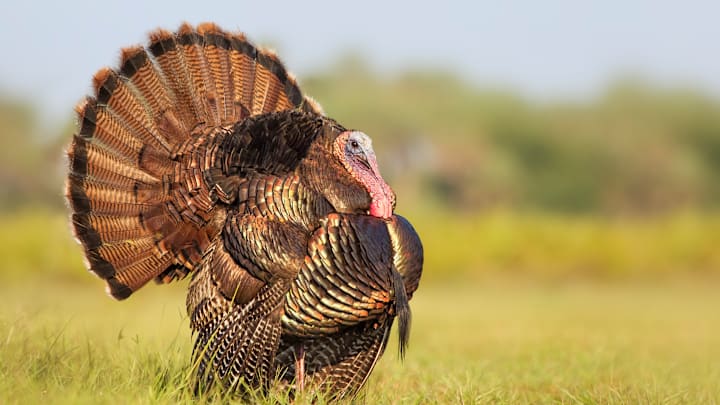Don’t be fooled by the rumors that turkeys are silly. These impressive birds are smarter than you think—and these facts below help prove it.
1. Turkeys (the birds) were named after Turkey (the country).
The turkey is a North American bird, but it shares its name with a country in Asia. Turkish traders had been importing African guinea fowl to Europe for some time when North American explorers started shipping Meleagris gallopavo back to the Old World. The American birds looked kind of like the African turkey-cocks, and so Europeans called them turkeys. Eventually, the word turkey came to describe M. gallopavo exclusively.
2. Turkeys nearly went extinct.
By the early 20th century, the combination of overzealous hunting and habitat destruction had caused turkey population to dwindle to just 30,000 birds. With the help of conservationists, the turkey made a comeback. The birds are now so numerous that they’ve become a nuisance in some parts of the country.
3. Turkeys have two stomachs.

Like all birds, turkeys don’t have teeth, so they’ve got to enlist some extra help to break down their food. Each swallowed mouthful goes first into a chamber called a proventriculus, which uses stomach acid to start softening the food. From there, food travels to the gizzard, where specialized muscles grind it into smaller pieces.
4. Female turkeys don‘t gobble.
Turkeys of both sexes purr, whistle, cackle, and yelp, but only the males gobble. A gobble is the male turkey’s version of a lion’s roar, announcing his presence to females and warning his rivals to stay away. To maximize the range of their calls, male turkeys often gobble from the treetops.
5. Turkeys sleep in trees.
Turkeys have many natural predators, including coyotes, raccoons, eagles, and owls. As the sun goes down, the turkeys go up—into the trees. They start by flying onto a low branch, then clumsily hop their way upward, branch by branch, until they reach a safe height.
6. Both male and female turkeys have wattles.

The wattle is the red dangly skin under the turkey’s chin. The red skin on top of the beak is called a snood. Both sexes have those, too, but they’re more functional in male turkeys. Studies have shown that female turkeys prefer mates with longer snoods, which may indicate health and good genes.
7. Turkeys have excellent vision.
Turkey eyes are really, really sharp. On top of that, they have great peripheral vision. Human vision ranges about 180 degrees from left to right, but given the placement of their eyes on the sides of their heads, turkeys can see 270 degrees from left to right. They also have better color vision than we do and can see ultraviolet light.
8. Turkeys are fast when they need to be.
Perhaps you wouldn’t guess it by looking at them, but turkeys can really book it when they need to. On land, a running turkey can reach a speed of up to 25 mph—as fast as a charging elephant. Turkeys can also fly 40 to 50 mph for short distances.
9. Turkeys are smart birds.

Turkeys can recognize each other by sound, and they can visualize a map of their territory. They can also plan ahead and recognize patterns. But in other ways, they may seem a little less sharp: Male turkeys will attack anything that looks remotely like a threat, including their own reflections in windows and car doors.
10. You can prevent turkey attacks.
Spring is mating season for wild turkeys, and to win over females, male turkeys will try to dominate anything that moves. And a belligerent turkey can be dangerous. Wildlife biologists advise those who find themselves in close quarters with an aggressive turkey to make themselves appear large and imposing to avert attack. People can also avoid such interactions in the first place by not feeding wild turkeys, sweeping up excess seed from backyard bird feeders, and keeping turkeys away from their property with a garden hose or fencing.
A version of this story appeared in 2017; it has been updated for 2022.
